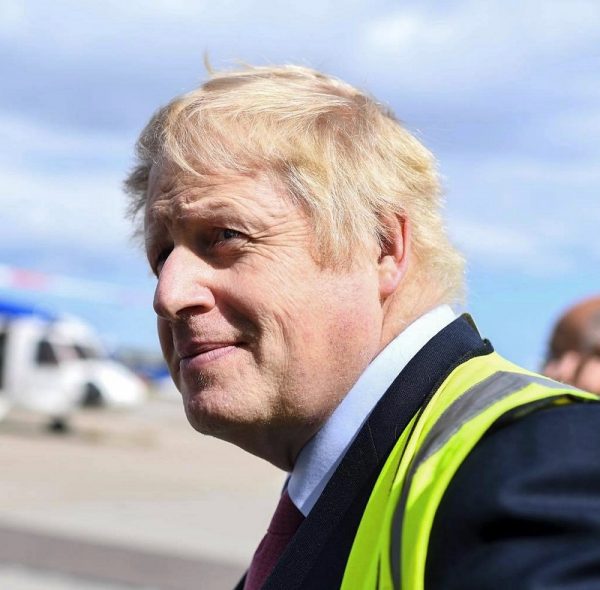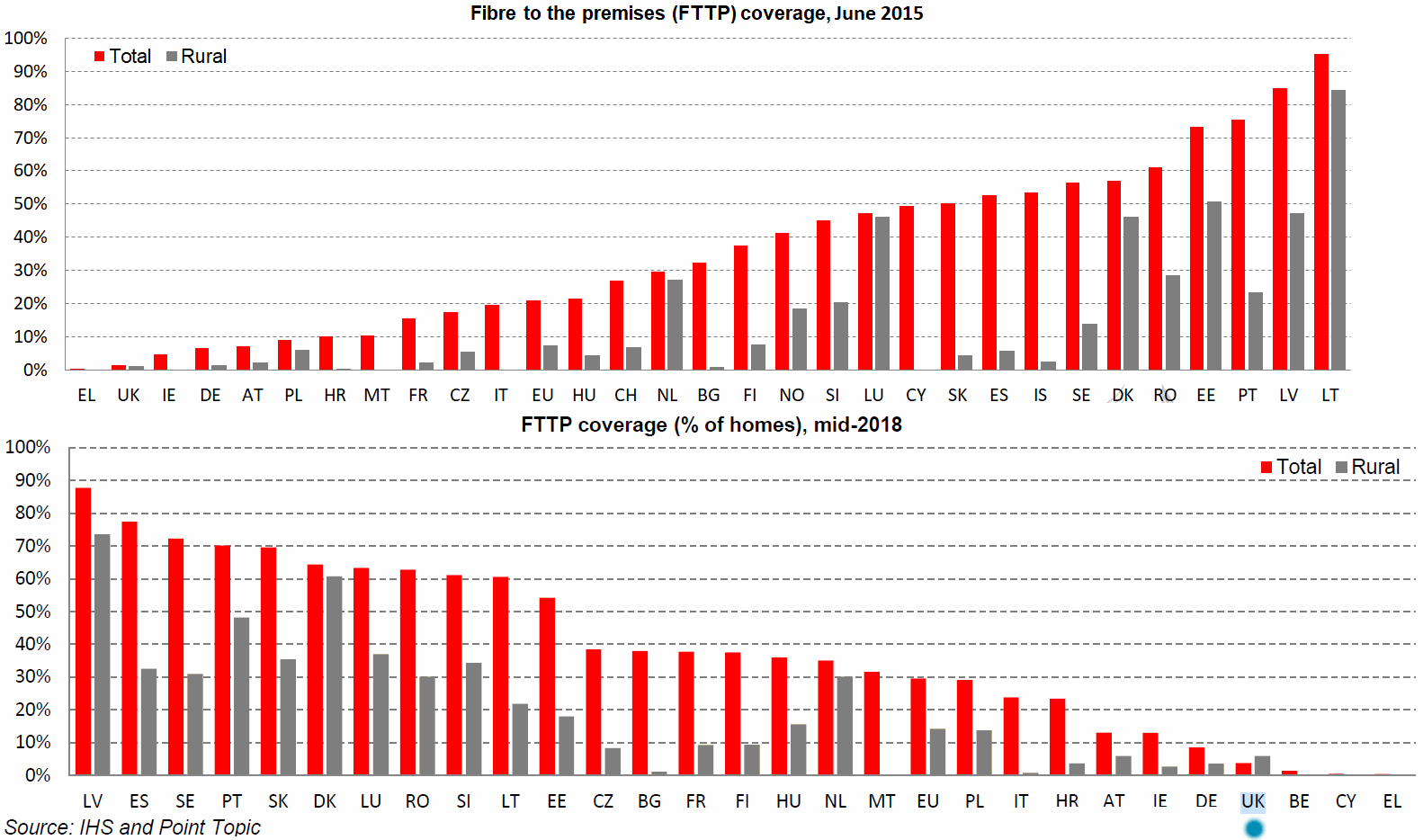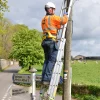The Challenges of Boris Johnson’s 2025 Full Fibre for All UK Pledge

The new Prime Minister for the United Kingdom, Boris Johnson, recently confirmed his ambition to deliver “full fibre” ultrafast broadband nationwide by 2025 but many, ourselves included, have wondered aloud whether or not that’s even possible. We take a closer look.
The previous administration pledged to deliver Gigabit capable Fibre-to-the-Premises (FTTP) broadband ISP connections to 10 million UK premises by 2022, then 15 million by 2025 and they also held an aspiration for “nationwide” coverage by 2033 (here). All of this was underpinned by various regulatory and policy changes (Future Telecoms Infrastructure Review), business rates relief and several investment / voucher schemes.
At this point those familiar with the reality of deploying fibre optic cables down every single street and lane in a country, especially one dotted with masses of individual houses, will know that the previous 2033 date was already quite optimistic. Other countries have been deploying FTTP at scale for a decade or more and even for them the final 30-40% of premises is expected to be several times slower and more expensive to reach.
Advertisement
Despite this Boris Johnson called the 2033 aspiration “laughably unambitious” and said that he could “unite our country” by delivering “full fibre for all … in five years at the outside” (here). Top marks for the bold and most welcome aspiration but what’s less clear is how this is going to become possible. Grade F for the lack of detail and any sign of committed funding.
Boris Johnson, Prime Minister, said (Victory Speech):
“And we are once again going to believe in ourselves and what we can achieve. And like some slumbering giant, we are going to rise and ping off the guy ropes of self-doubt and negativity with better education, better infrastructure, more police, fantastic full-fibre broadband sprouting in every household.
We are going to unite this amazing country and we are going to take it forward. I thank you all very much for the incredible honour that you’ve just done me. I will work flat out from now on with my team that I will build.”
The challenge now is how the Prime Minister will deliver on such a commitment, particularly as we’re not aware of any other country in the world – except maybe for the odd city-state with very different considerations to the UK – where it has been possible to achieve the sort of deployment pace that would be required.
Some counties, such as Spain, have done better than others but that’s because most of their people live in apartments (c.66%), which are significantly cheaper to connect (here). By comparison most UK people live in individual housing (only about 15% in apartments), which is a much slower and more costly market to tackle. Apartment living is fairly common across the EU (42% average), except in Ireland, the UK and a few other states.
The above also includes some countries that have benefited from significantly more public funding than the UK and, sometimes, play host to a less competitive market. The latter is often seen as a positive for FTTP since it makes the investment return more dependable, rather than in an aggressively competitive market – like ours – where prices are driven down (i.e. the investment case gets harder).
Advertisement
Just take a look at the 2015 vs 2018 change below to see how much progress is being made across 3 years and remember, nearly all of this comes from the relatively easy and quick urban bits. Even in Sweden (SE), which has been at the FTTH game since 2006, they’re still several years away from 100% coverage and that final 30-40% has really slowed the deployment pace.

Key Challenges
At present around 2 million premises (7%+) can already access FTTP and that still leaves around 28 million left to tackle, which when taking in policy delays means we probably need to be building at a rate of around 5 million premises per year (the previous 2033 target required c.2 million+) from start to finish.
Flip over to page 2 to continue our summary of the challenges, deployment costs and feedback.
Advertisement
Mark is a professional technology writer, IT consultant and computer engineer from Dorset (England), he also founded ISPreview in 1999 and enjoys analysing the latest telecoms and broadband developments. Find me on X (Twitter), Mastodon, Facebook, BlueSky, Threads.net and Linkedin.
« ISP BT Sees 40% Increase in Internet Traffic from Fortnite Season 10























































Sooo.. magic money.. forest?
No, simple this and numerous other things will be dropped citing the EU (no deal Brexit) as the cause.
(When the reality is of course hia continual lieing) …
Simple answer: send in the drones! (Just hope they don’t get stuck halfway down the line…)
Good at last a Prime Minister with some ambition. BT have been draging thier feet for years prefering to protect thier investment in copper.
I think we should make the infrastructure upgradeable to 100Gb/s.
think you should read the IPSa letter first
before making such comments
That is quite an unrealistic goal and not warranted at this stage. Commenting on your other statement about BT protecting their copper investment you should do some research. The chief technical officer for BT, Dr Cochrane stated in 1979 that copper was far from sufficient for a digital future and had suggested fibre as the way forward but between them and 1990 they had invested heavily in fibre technology only to be told by the, then, prime minister, Margaret Thatcher that it wasn’t going to happen due to BT being the monopoly of the industry and the rest is history.
Just thought you would like to know before you make uninformed claims.
Meanwhile, as the race for full fibre gallops ever onward, the UK’s fixed wireless operators will continue to build, faster and cheaper than fibre, with technology delivering 100 Mbps and more, oodles enough for the average connection. Government ambitions seem predicated on 100% uptake of 100% coverage. Even without FWA, 4G and 5G, chances of that happening, as Boris would say ‘are vanishingly small’. Yes, I work for Village Networks, the small but perfectly formed rural ISP, whose wireless technology has allegedly always been doomed, for at least the last 15 years.
As usual, a great article from Mark.
It’s undoubtedly ambitious to try and deliver FTTP at such scale in a shortened period from the last government statement – and without any detail of funding.
It’s unlikely, given the recent comments from the new PM about effectively remaining under EU control after Oct 31 – and the ERG/Brexit supporting MPs reaction – that this current government with a majority of just 1 – will still be here much after Christmas, so delivery of FTTP is probably a moot point and will always remain just a headline.
There was however a few years back a great cross-party Lords report that drew on great expertise and made eminently sensible suggestions. One of these was for government to fund/support/encourage an FTTN (fibre to the node) infrastructure with potentially every village, parish, neighbourhood being able to get access to backhaul – that could be used by every ISP/provider.
With that expense and challenge covered, it would be simple to open up the connection to it to a multitude of smaller businesses, local communities, and others who may wish to complete the final mile.
That dis-aggregation and opening of the market would be hell for the big incumbents – but it would stimulate competition and open up the market – getting people connected.
Even if that were limited to the last few “difficult to connect” areas (but starting immediately) it would be highly beneficial.
Cricky Mark Jackson, after reading that little jem I have a headache, I suspect Boris will too, if he were to read this, however Boris is to be applauded (not to loudly I have a headache), it is great that Boris would like to see that achieved in such a little timeframe.
Technically I think it’s just about doable, however the biggest roadblock will be wayleave, I can see that hitting the courts because someone from the awkward brigade does not want boots trampling over their primroses
It’ll never happen, it’s a Tory PM ergo they just lie and lie and lie (like most politicians these days).. he won’t deliver Brexit and he certainly won’t get full fibre to my doorstep in the next 5 years!
It’s just all talk to make you vote for him in the inevitable up coming general election.
Boris Johnson will be gone on the 1st of November 2019 because he will fail to deliver Brexit Leave with no deal. General Election will wiped out Tory government in this autumn mean we won’t getting full fibre under new PM.
This is what Boris already senses!
He knows he probably won’t be in power for another 5-6 years so it is easy for him to promise Full Fibre for the whole country by then.
So when he loses in the next General Election and Full Fibre by 2025 is unachieved, he can then use that excuse to blame the opposition parties whoever wins the election for not being able to deliver it.
The same goes for Philip Hammond’s pledge for Full Fibre 2033, even that feels too unrealistic.
As I mention before calculation-wise with a 3% coverage per year, Full Fibre in 2025 will only be 25% and by 2033 it will be 49% unless the coverage jumps to much higher than current 3%.
Full Fibre for 2025 can only happen if UK FTTP coverage jumps by 15% every year. But that acceleration is hard to believe or imagine when the current rate is only 3% from 4% last year to 7% this year.
No party will be able to deliver Full Fibre by 2025! As for 2033 that’s more realistic but then again the jump needs to be by 6-7% per year. 6×14=84% 84+7= 91% FTTP coverage. In other words from now until 2033 in the next 14 years we need FTTP coverage to double from current 3% to 6-7% and even that’s a big ask, but way more doable. But as we can see even that doesn’t quite hit 100% never mind trying to achieve it in less time.
That of-course doesn’t make me a pessimist, it makes me a realist. But Boris Johnson will surely try to use the word ‘pessimist’ against the opposition parties to defend his unrealistic optimism. He is not being optimistic, he is being silly!
The Tories will win the next GE because of Boris, those that want to leave the EU (with or without a deal) were not convinced by Theresa May back in 2017 that’s why she done so badly, that won’t happen next time especially as the Lib’s will take votes from Labour.
No, The Tories will not win the next General Election simply because the Brexit party will take away a portion of their votes like in the example of Brecon and Radnorshire by-election where Lib Dem won thanks to 3000+ votes for the Brexit party. A constituency that voted leave. Yet Lib Dem are a Remain party.
This is why Boris is making these Fibre promises because he knows that a large chunk of Brexiteers in deprived areas of the UK also coincidentally have poor broadband. If he can’t convince them that No Deal Brexit will happen, how about try manipulating them by offering Full Fibre instead?
This is all political, No Deal Brexit is simply rhetorical because Boris thinks that by saying that he will be able to sway Brussels into agreeing a better deal. This strategy will most likely fail as the EU are not at all scared of a No Deal Brexit. Not to mention tackling the Irish backstop is almost impossible. Britain will lose Northern Ireland and Scotland. Any sensible Prime Minister will not take that risk.
Paradoxically, I have to admit No Deal Brexit is even more unrealistic than delivering Full Fibre to the entire UK. When October 31st No Deal does not happen, Boris will lose his popularity and when a GE happens he will lose dramatically. Just wait and watch!
@Rahul
Look forward to meeting you back here in November 🙂
The Brecon and Radnorshire by-election has no bearing on what a would happen in a general election. Local elections rarely do.
The fact the lib-dems won the by-election there also means nothing. The other remain parties basically stepped to one side to allow them to have a chance at winning. If you count the vote that went to all the leave parties (and they had all done the same thing IE basically stand aside just for one to properly campaign) you would had seen things go the other way (Something most media have failed to consider).
The original referendum vote there was 51.86% leave 48.14% remain. SO far from conclusive on either side of that debate even back then.
“When October 31st No Deal does not happen”
31st October is the deadline if there is not a deal in place by then then we are basically out with no deal by default unless Boris and the EU agree on yet another extension and neither of them are likely to want or do that. I suspect his plan is just to let the date lapse unless they start talking on the points he has mentioned.
I think based on your little real understanding of what is going on you have been watching one too many lilly liberals panic like a headless chicken BBC commentators recently.
Boris plays the clown but he is not as stupid (thats not to say he is a bit daft) as some that have been EU funded media brainwashed seem to think. Why do you not think he has bothered going back to Europe to discuss things further? He has told them either we talk about x, y and z or we do not. Running back to them every 5 minutes like May was just makes you look weak and desperate. Like or hate the man he has more of a clue how to play the negotiation game than dotty May did, hell i actually doubt she even understood what she was agreeing to.
There is no way he can deliver on half of what comes out of his mouth, and i do not deny half the time he is his own hype train but i suspect if he is given a chance he will do more for the country than Cameron and May did. (then again that would not be hard).
To think the Lib-dems will win a general election with their daily changing opinions on things (god really help us all if they did) or Corbin even has a chance now after him and his party could not make up their mind on Europe (his worse mistake since leadership of Labour) until it was too late is frankly hilarious. If there were a general election tomorrow there would be no clear winner, the same as there has not been for the past few. (IE some coalition would still be needed… oh and haven’t they worked so well so far!).
None of the parties are clear enough on policies nowadays, especially when challenged, or are just outright not trusted, that is why the vote ends up so split. People either do not bother, do not know, or the real Luddites just vote the same as they have for decades.
The fact there is still arguing about being in or out of Europe and its infected sites like this is even more pathetic than the parties and what is going on itself.
@Summer Is Here: I have long memories and I did not forget this topic and your post! 😉
November 1st has arrived, here I am, Brexit has not happened and my predictions end up being accurate as usual! 😀
Boris did not deliver Brexit and his deal was obviously not going to pass parliament and the deadline will have been extended.
We cannot trust this Prime Minister neither on Brexit nor on delivering Full Fibre to the rest of the country by 2025!
The question is whether we will even be able to get Brexit done by 2025, never mind Full Fibre for all by then!
This great. But when can I have just a broadband connection or a mobile signal!
I know I can ask for it next year (USO) but I won’t get it.
The definition of “full fibre“ has to exclude Virgin Media’s HFC network if only because VM is not going to replace it with fibre, madness to do so when DOCSIS 3.1 and some other network upgrades will provide speeds comparable with those of FTTP operators.
Serious question, but if their infrstructure can deliver gigabit speeds then why isn’t this considered FTTP? Because the cables aren’t literally fibre optic?
Because fttp means fibre to the premise.
Coax isn’t fibre
Surely it’s the performance and upgradability that matters, not the material of construction – that’s in danger of drifting into marketing hype…
I have learnt to recognize a sure sign when BoJo is telling lies. His mouth flaps open and closed.
StarLink…
Their goal should be to provide 1/10/100 gbps to every home, not just FTTP, including utilising wireless, laser (FSO/FSL), 5G and satellite communication such as OneWeb, SpaceX Starlink. It could be cheaper.
I read as a boy in the 1970’s about fibre optics. I got excited when our telephone exchange went digital in the late 80’s. Surly fibre was soon to follow. They were starting to put it into offices at least, but only for telephones.
I seem to recall every Prime Minister since Tony Blair has made promises on broadband. And here we are. I’m not hopeful.
Rather than 100% FTTP I’d rather see a 100% superfast (whether FTTP, 4G, fixed wireless etc.) target by 2025 (or sooner). Pushing for 100% FTTP (which can’t possibly be done by 2025) means that the cities and urban areas will get FTTP, and the slow and expensive to deploy rural areas get left until last (as usual). Most urban areas have superfast options already – they will end up with FTTP and rural areas will be left with ADSL.
Well look at the bright side industry and government are on the same tack.
At least FTTP is now in the top five issues agenda.
Let’s hope that something really anything that makes the rollout easier/cheaper/quicker comes out of this.
Johnson is an inveterate liar (he calls it “sandpapering the truth”) and has no chance whatsoever of delivering on this promise. Plus, given the dire economic warnings about the effect of Brexit (the Governor of the Bank of England, the CBI, the Government’s own impact assessments) there will be other economic necessities around the corner. If it comes down to the NHS or FTTP, I know what I’d choose…
Why does your 2015 bar chart go from high to low penetration and your 2018 bar chart go from low to high penetration. Is someone trying to confuse the man on the Clapham omnibus???
Did Boris write it on the side of a bus with all of his other lies?
Five minutes after the election he will have forgotten every promise.
I echo some some of the points in an earlier post by Aeurias. Whilst providing ultrafast fibre broadband nationwide is likely not feasible by the PMs 2025 timeline. Providing the same level of ultrafast broadband by utilising Low Earth Orbit i.e. OneWeb satellites will be possible by end 2021, well within the timeframe, and without having to deal with the complications associated with digging up the countryside etc. This is also likely to be far cheaper than fibre.
What does “Rural” and “total” mean on the charts? I assume rural areas vs total
How come the UK has more FTTP in rural areas than total?
BDUK and other programmes. Urban areas were getting FTTC, areas where FTTC wasn’t an option were ignored, rural areas were getting FTTP where FTTC didn’t make sense.